Japanese Variety Shows
Since Sachi and I moved in together, I’ve been seeing a lot more Japanese TV, and have noticed certain features and patterns that I had seen before, but had not really thought much about. This applies primarily to the Japanese Variety Shows, the ones that include guests and maybe some special segments. However, a lot of these features seem to apply generally to many TV shows.

1. Subtitles. A lot of what is said on these shows is subtitled, usually in large, bold, and sometimes colored text. We’re talking Japanese subtitles for Japanese speech. The subtitles will appear even when everyone is speaking perfectly clearly. They do not appear for every word spoken, and do not appear to be for better understanding–they simply seem to be a form of punctuation.
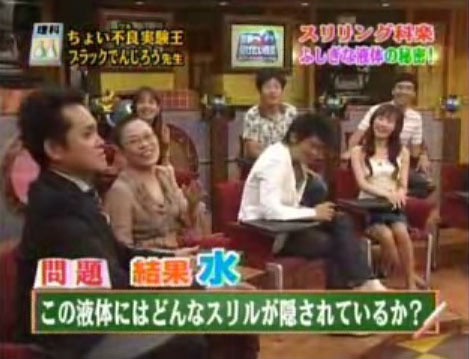
2. Lots of guests. There may be a few star guests, but often there’s a whole panel, sometimes more than a dozen guests seated in two tiered rows, with two or three hosts running the show. Panel discussions seem to be the norm for many of these shows.
3. Crazy Games. A lot of shows include bizarre games, like dressing up as a giant piece of sushi and walking a tightrope over a vat of oatmeal or something. A lot of these gags, for some reason, involve pools or vats of water, and many involve costumes. Today, Sachi was watching a show where the contestants had to dress up as celebrities (one painted himself gold, put disks over his eyes, and was supposed to be C-3PO), then jump off a platform holding onto a latex-like rope-swing which would snap under too much pressure, and navigate their way to a rolling cylindrical pillow over a pool of water; after rolling the pillow to the end, one would have to jump onto a floating yellow ball and maintain balance. The games are usually made to be virtually impossible. Another segment had a man dressed as a priest surrounded by men dressed as nuns; the priest had to throw himself about five feet forward onto a medium-sized exercise ball, belly-first. And, oh yeah–there are often a lot of men dressed up in drag.
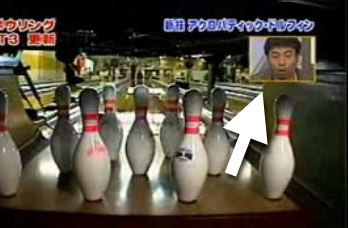
4. Picture-in-Picture Reaction Shots. When they switch to a video of something or another, there is an inset frame in one corner that shows reaction shots of guests, usually switching from one guest to another every 5-10 seconds.
5. Motion Picture Soundtracks. Few if any of these shows seem to have original music. Instead, they just steal stuff from elsewhere. In the course of one hour, you may hear bits from a few dozen different movie soundtracks. If the show’s director finds a music cue they like, be prepared to hear it every few minutes.
This all plays to a conclusion I came to long ago about Japanese entertainment: it is so formulaic as to make the most formulaic of all U.S. entertainment appear stunningly unique. In my experience, with few exceptions, Japanese samurai dramas, detective dramas, romance dramas, variety shows, etc. are all very similar, following very close to a basic set of rules. For example, in Japanese romance dramas, the girl almost always dies in the end, for some reason.
Maybe that’s one reason that U.S. TV series can be so popular in Japan: there’s not much local competition that stands up. Especially in production value–American TV shows often look expensive, with a cinematic feel, excellent special effects, and solid sets and designs. Japanese shows rarely have the same innovation or quality of production that you see coming from the U.S.–and that’s a shame. Because when Japan gets the chance, they can come up with some of the craziest shit imaginable.
My favorite Japanese TV show–not that I watched it more than a few times, but because it made me laugh like hell–was a teen-idol detective drama titled “Sukeban Deka,” which roughly translates to “Delinquent Female High School Student Police Detectives.” They were “delinquent” because they used makeup and accessorized, in addition to their smoldering, resentful, and pouting attitudes. Each girl had a unique weapon; the most famous was the girl with the badass yo-yo.
Near the end of an episode, this small, diminutive Japanese teenage girl in a sailor uniform would be surrounded by a dozen or more big, hulking, hairy, tattooed yakuza gangsters. Then she’d pull out her badass yo-yo. “Stand back!” she’d warn, but the yakuza gangsters would foolishly ignore her. She’d snap back her hand, and then let go the badass yo-yo. We’d get a shot of the badass yo-yo with the background whizzing by (WHISH-WHISH-WHISHHH!!). Then the badass yo-yo would bash one of the yakuza gangsters in the noggin. Half the yakuza would then flee in terror, while the 16-year-old delinquent female high school student police detective would pick off the rest one by one with the badass yo-yo, with all the exaggerated sound effects you’d expect in a kung-fu movie.
It was the funniest damned thing I have ever seen.
The TV show went on to become three if not more major motion pictures in Japan. The posters below show one of the original movies, and a more recent remake.
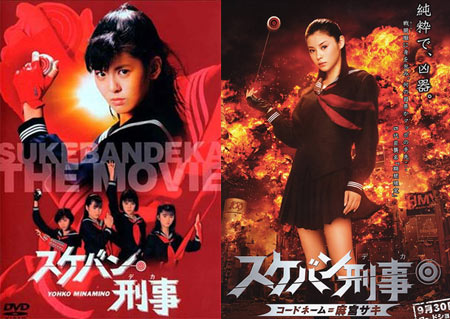

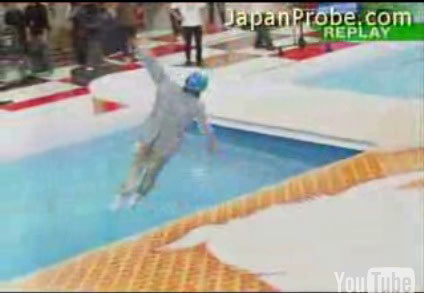
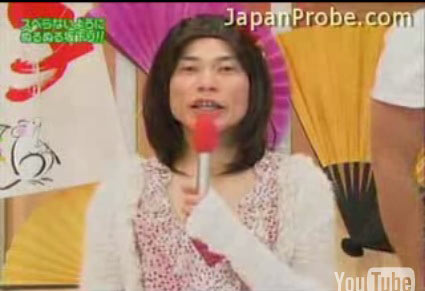
nice legs!
It may be a rare statement among North Americans in Japan, but I really enjoy many Japanese variety shows. I don’t watch them so often (I have a three year old son…) but on the occasions that my wife and I turn on the TV late at night, we generally laugh our asses off.
There’s really something to be said for shows that push the boundaries of the absurd- for example a show where they tested what sleeping aids worked under extreme circumstances. They took a pair of comedians and had one of them trying to sleep on a 10 meter high dive platform, in the middle of a shopping mall, and in other insane places. They then gave him aids like a aromatherapy, a hot water bottle at his feet, and being read bedtime stories to help him sleep. I guess you have to see it…
Basically, a lot of Japanese comedians really are very funny if you understand Japanese. If you don’t, all these panel discussions, subtitles, etc. look all very inane and repetitive. If you can clearly understand the nuances of what they’re saying, a lot of it is laugh-out-loud funny.
But I guess there’s a lot to be said for taste. I personally love Shimura Ken style humor, which perhaps puts me in my own category among Americans…
I don’t know what Japanese Romance shows you are watching where the girl always dies–but that isn’t true at all. In fact, statistically and rating speaking, the most popular Japanese romance show end happily. One of the most popular in recent years is ‘Hana Yori Dango’ and it did not have a single person die.
Which shows are you watching?
Alyss: I haven’t been watching too many shows, but I am referring more to one-off dramas and TV movies, not TV series with recurring characters. A lot is also based on what I have seen since I came to Japan in the mid-80’s. The first I recall was a movie with Seiko Matsuda, “Legend of Plumeria” I think it was. Just the other night, I saw bits of a drama my wife was watching; the show began with a girl throwing herself off the top of a tall building. I’ll grant you that my “almost always” estimation is too much, but it sure as heck happens far more in Japanese drama than in western drama.
woooo!!!! Matsuura Aya